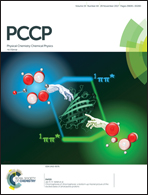Solvatochromic dye LDS 798 as microviscosity and pH probe†
Abstract
Styryl dyes, specifically LDS group dyes, are known solvatochromic and electrochromic probes for monitoring mitochondrial potential in cellular environments. However, the ability of these dyes to respond to fluctuations in viscosity, pH and temperature has not been established. In this study, we demonstrated that LDS 798 (also known as Styryl-11) can sense environmental viscosity (via fluorescence lifetime changes) as well as pH changes (ratiometric intensity change) in the absence of polarity variations. Polarity changes can be probed by spectral changes using LDS 798. Therefore, all properties of the media should be considered, when these types of dyes are used as electrochromic/solvatochromic sensors in cellular environments.



 Please wait while we load your content...
Please wait while we load your content...